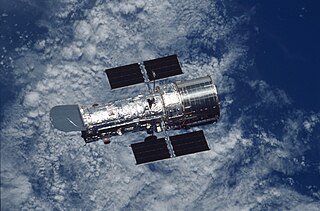
Astronautics is the practice of sending spacecraft beyond Earth's atmosphere into outer space. Spaceflight is one of its main applications and space science is its overarching field.

A launch vehicle is typically a rocket-powered vehicle designed to carry a payload from Earth's surface or lower atmosphere to outer space. The most common form is the ballistic missile-shaped multistage rocket,but the term is more general and also encompasses vehicles like the Space Shuttle. Most launch vehicles operate from a launch pad,supported by a launch control center and systems such as vehicle assembly and fueling. Launch vehicles are engineered with advanced aerodynamics and technologies,which contribute to high operating costs.

The Scout family of rockets were American launch vehicles designed to place small satellites into orbit around the Earth. The Scout multistage rocket was the first orbital launch vehicle to be entirely composed of solid fuel stages. It was also the only vehicle of that type until the successful launch of the Japanese Lambda 4S in 1970.

Bélier is the designation of a French sounding rocket family. Three versions of the Bélier were launched between 1961 and 1970 at the CIEES launch facility at Hammaguir,the Salto di Quirra and Ile du Levant missile ranges,and Kourou Space Center.

Bérénice was the designation of a four-stage French atmospheric reentry test rocket,developed by O.N.E.R.A..

Topaze is the designation of a French sounding rocket. The Topaze was developed by several French companies,notably Nord Aviation and Sud Aviation,and built by SEREB and was the first guidable French sounding rocket.

Monica is the designation of a small French sounding rocket. It was intended as a cheaper counterpart to the relatively expensive Veronique rockets.

The Éridan is a two-stage French sounding rocket,which results from the use of the Stromboli engine for the first and second stages.

The Dauphin is a French sounding rocket,flown six times between 1967 and 1979. It consists of a modification of the first stage of the Dragon with a larger payload nosecone.

Robert Albert Charles Esnault-Pelterie was a French aircraft designer and spaceflight theorist. He is referred to as being one of the founders of modern rocketry and astronautics,along with the Russian Konstantin Tsiolkovsky,the Germans Hermann Oberth,Wernher Von Braun and the American Robert H. Goddard.
Mélanie is a French solid rocket motor,16 cm in diameter,initially used as first stage of the Monica rocket.

This comparison of orbital launch systems lists the attributes of all individual rocket configurations designed to reach orbit. A first list contains rockets that are operational or in development as of 2023;a second list includes all upcoming rockets and a third list includes all retired rockets. For the simple list of all conventional launcher families,see:Comparison of orbital launchers families. For the list of predominantly solid-fueled orbital launch systems,see:Comparison of solid-fueled orbital launch systems.

Progress M-36 was a Russian unmanned Progress cargo spacecraft,which was launched in October 1997 to resupply the Mir space station.

Progress M-40 was a Russian unmanned Progress cargo spacecraft,which was launched in October 1998 to resupply the Mir space station,carry the Sputnik 41 satellite and the unsuccessful Znamya 2.5 solar mirror.

Progress M-41 was a Russian unmanned Progress cargo spacecraft,which was launched in April 1999 to resupply the Mir space station and carry the Sputnik 99 satellite.

The Antarès (OPd-56-39-22D) was a French multistage rocket designed by ONERA for reentry studies. In the late 1950s,the study of missile warhead reentry necessitated the development of a more robust rocket than the existing OR,VD and OPd series. The Antarès rocket,designated OPd-56-39-22D during its developmental phase,was designed to facilitate the study of kinetic heating on objects flying at speeds up to Mach 7.

Tibère was a French atmospheric reentry test rocket developed by O.N.E.R.A.. It evolved from its predecessor,Bèrènice,with development initiated in 1965 to support the ELECTRE reentry experiment program. Tibère,standing at a height of 14.5 m and weighing 4.5 tons,operated as a three-stage rocket.

The inaugural member of ONERA sounding rockets fleet,the Tacite,was a single-stage vehicle,used between 1965 and 1968.

The Titus sounding rocket was developed specifically by ONERA for observing the solar corona and conducting spectral analysis of the Sun's ultraviolet rays during the November 1966 solar eclipse in Argentina. The two-stage rocket,standing just over 11.5 meters tall and weighing 3045 kg without payload,could launch 400 kg to an altitude of 250 km.

LEX was a French experimental hybrid-propellant sounding rocket,developed by ONERA. It had the objective of testing a lithergol fueled rocket engine. It was the first rocket in history to use this technology,flying 8 times between 1964 and 1967.












